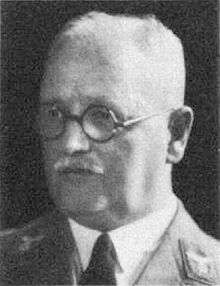Franz Xaver Schwarz
| Franz Xaver Schwarz | |
|---|---|
 Schwarz, 1938 | |
| Personal details | |
| Born | 27 November 1875 |
| Died | 2 February 1947 (aged 71) |
| Nationality | German |
| Political party | Nazi Party, SS-Oberst-Gruppenführer |
Franz Xaver Schwarz (27 November 1875 – 2 December 1947) was a German Schutzstaffel (SS) functionary and politician in Nazi Germany. He served as Reichsschatzmeister (National Treasurer) of the Nazi Party (NSDAP) during most of the party's existence.
Early life
Schwarz was born in Günzburg, the seventh of eight children born to a master baker and his wife. He was educated up to a high school level at the Günzburger vocational training school. Schwarz married Berta Breher on 26 August 1899. From 1900 to 1924, except for the war years of 1914 to 1918, he worked as an "administrative official" in the city government of Munich.[1] During World War I, Schwarz served as a second lieutenant in the German Army.[2] Due to gastric troubles which afflicted him for his entire life (he was considered 30 percent disabled in that war), he was spared field duty beginning in 1916.
National Socialism
Schwarz joined the Nazi Party in 1922.[2] Schwarz participated in the failed Beer Hall Putsch of November 1923. With the re-establishment of the Nazi Party in Germany on 27 February 1925, Schwarz became party member number six.[3] He left his job as an accountant at the Munich City Hall to become the full-time treasurer of the Nazi Party on 21 March 1925.[2] He rebuilt the financial and administrative functions of the party. It was Schwarz who raised the money for the publication of Hitler's book, Mein Kampf.[2] In April–May 1930 Schwarz negotiated the purchase of the party headquarters, the Brown House at 45 Brienner Straße in Munich.[1]
From 16 September 1931 forward, Schwarz had control of all financial matters of the Nazi Party.[1] He was elected to the Reichstag in 1933, representing the Franconia electoral district and continued thus to the end of World War II. He was also named a Reichsleiter (Reich Leader), which was the second highest political rank of the Nazi Party.[4] Hitler attended Schwarz's 60th birthday celebration on 27 November 1935.[4] Hitler's will, dated 2 May 1938 (which left his entire fortune to the party) included the provision that it be opened in Schwarz's presence.
Besides the party treasury (largely based on membership dues), Schwarz was responsible for the central assignment of NSDAP unique membership numbers. When members died or stopped paying dues, the old numbers were not freed up for new members. If old members picked up their dues later a new party number would be assigned. The Nazi Party had 8.5 million members on the books by 1945.[5]
Schwarz was regarded as an able administrator who generally kept out of party politics.[6] For instance he is only mentioned twice in Joseph Goebbels's diaries. The first time (9 April 1926), Goebbels wrote dismissingly of him, but by November 1944, the Propaganda Minister's attitude had changed; he now regarded Schwarz as one of the most reliable and respectable party men.
SS membership

In June 1933, Schwarz joined the Schutzstaffel, and his SS member number was 38,500. On 1 July 1933 he was appointed SS-Obergruppenführer.[3] Later, he was one of only four people to have held the rank of SS-Oberst-Gruppenführer.[4]
On 5 June 1944, Schwarz received a high military award, the War Merit Cross, 1st class with Swords (Kriegsverdienstkreuz 1. Klasse mit Schwertern) by Hitler for his work during the Munich air raids of 24–25 April of that year. Further, Schwarz led a Volkssturm battalion in Grünwald at the end of the war. He was arrested by the Americans.
Death
Schwarz died in an Allied internment camp near Regensburg on 2 December 1947, due to recurring gastric troubles. He was 72. In September 1948, Schwarz was posthumously classified by the Munich de-Nazification court as a "major offender".[4]
See also
Notes
- 1 2 3 Zentner & Bedürftig 1997, p. 851.
- 1 2 3 4 Hamilton 1984, p. 340.
- 1 2 Biondi 2000, p. 7.
- 1 2 3 4 Hamilton 1984, p. 341.
- ↑ McNab 2011, pp. 22, 23.
- ↑ Zentner & Bedürftig 1997, pp. 851, 852.
References
- Biondi, Robert (2000). SS Officers List: SS-Standartenführer to SS-Oberstgruppenführer (As of 30 January 1942). Schiffer Military History Publishing. ISBN 978-0764310614.
- Hallgarten, George W. F. (1952). "Adolf Hitler and German Heavy Industry, 1931-1933", The Journal of Economic History.
- Hamilton, Charles (1984). Leaders & Personalities of the Third Reich, Vol. 1. R. James Bender Publishing. ISBN 0-912138-27-0.
- McNab, Chris (2011). Hitler's Masterplan: The Essential Facts and Figures for Hitler's Third Reich. Amber Books Ltd. ISBN 978-1907446962.
- Orlow, Dietrich (1973). The History of the Nazi Party: 1933-1945. University of Pittsburgh Press.
- Weinberg, Gerhard L. (1955). "Hitler's Private Testament of May 2, 1938", The Journal of Modern History.
- Zentner, Christian; Bedürftig, Friedemann (1997) [1991]. The Encyclopedia of the Third Reich. New York: Da Capo Press. ISBN 978-0-3068079-3-0.
External links
| Wikimedia Commons has media related to Franz Xaver Schwarz. |
- Picture and an article (in German)
- Newspaper clippings about Franz Xaver Schwarz in the 20th Century Press Archives of the German National Library of Economics (ZBW)